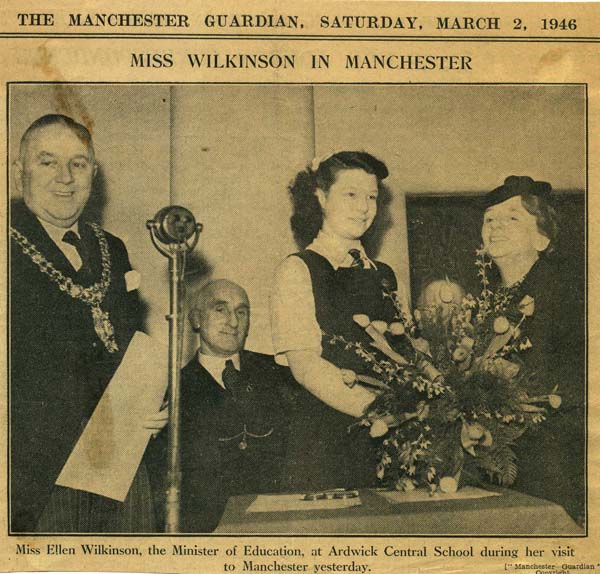|
Richard Wilkinson was the
eldest of 9 children whose Irish parents were described as hard
drinkers. Richard assumed responsibility for the welfare of his
siblings and it is suggested that his early experiences led him to
become a strict teetotaller and a Methodist. Richard became a
cotton operative and married Ellen Wood who was also a
Methodist. The couple lived at 41 Coral Street in
Chorlton-on-Medlock an area described as "a grimy district...each
house, two up two down, had a little back yard and a privy."
The
Wilkinsons, it was said, "managed
nicely, appreciated what hunger was,
but never went without a meal."
Richard and Ellen had four children. Anne born in 1881, Richard born in 1883, Ellen Cicely in 1891 and Harold in 1899. The photograph below is displayed here with the generous permission of Peter Harden and it shows baby Ellen with her mother on the left and her grandparents. 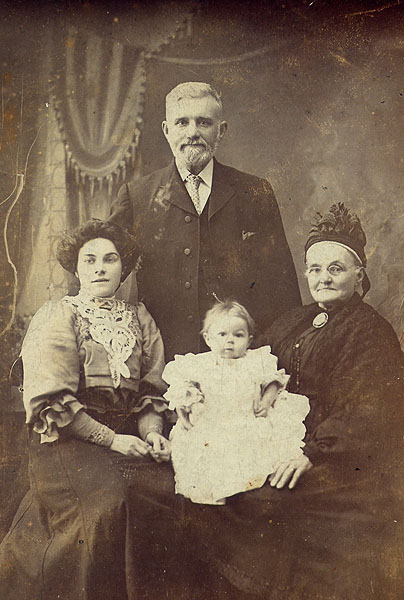 Young Ellen started school at
the age of six. She described it as "a filthy elementary school
with the five classes in one room". It isn't known which
school it
was but the two schools in the vicnity were St Paul's and St Luke's
Elementary schools.
The photograph below, also shown with the permission of Peter Harden, shows the young Ellen with her mother and her brothers Richard and Harold. Clearly evident is the firery red hair that became her trade-mark. She inherited it from her maternal grandmother who had red hair long enough that she could sit on it. Ellen had ambitions to grow hers long too but eventually tired of it and had it cut short. Soon after starting school Ellen became ill and, by her own account, would have died had it not been for, "a devoted and intelligent mother". She didn't return to school until she was 8 and was taught at home. There is a suggestion that this illness was a causal factor in Ellen's diminuative stature. She was a large baby but only grew to be 4 foot 10 inches as an adult. 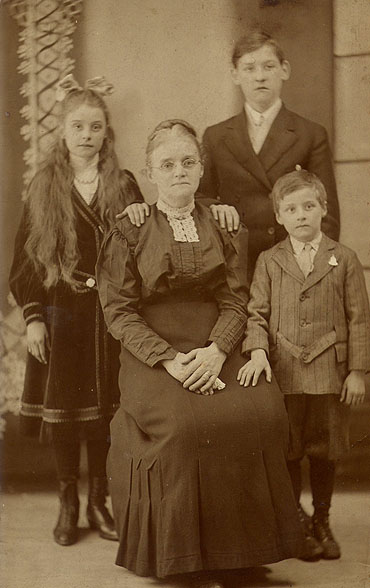 In 1902 Ellen entered the
Ardwick Higher Grade School which later became Ardwick Central School
and then Ardwick Technical School. She can be see third from the
left on the back row in this photograph of the Girls' Form taken
sometime between 1902 and 1906. The long red hair is still in
evidence.
 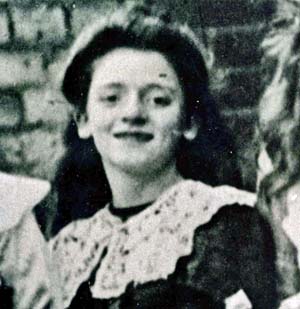 In 1906 Ellen won a £25
pupil teaching bursary which enabled her to attend the Manchester Day
Training College on Princess Street in central Manchester. She
attended College for half of the week and in the other half taught at
Oswald Road Elementary School. In 1910 Ellen became a student at
Manchester University where she developed her interest in socialism and
politics. In 1912 she joined the National Union of Women's
Suffrage Societies later becoming a district organizer. She also ran
the local branch of the Fabian Society. At the age of 24 she was the women's organiser of the Co-operative Employees, eventually gaining pre-eminence within NUDAW - a shopworkers' union. After being active in the women's sufferage movement she was elected as Labour member of Middlesbrough East in 1924. Identified with the far left, in fact Wilkinson was involved with various forms of labour movement activism. She was a tough character and resilient to jibes as both an orator and hardened union negotiator. She lost her seat in 1931. In 1935 she was elected MP for Jarrow, a seat she held until her death in 1947. In 1936 she was one of the leaders of the Jarrow March. What follows are excerpts from the 150th Anniversary edition of the Shields Gazette. As part of their special edition, they included a wonderful piece on the Jarrow March and Ellen Wilkinson figures prominently in it. I have chosen two images and some of the text to show here, with the generous permission of the Shields Gazette. 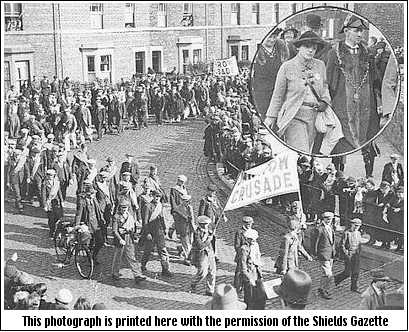 As they reach the end of the 1990s, most South Tynesiders, relatively affluent and well-nourished in comparison to their forefathers of six decades ago, would baulk at walking all the way to London. But that is exactly what 200 Jarrow men did on the morning of Monday, October 5, 1936. As the Gazette wrote at the time: "The tramp, tramp of Jarrow men, swinging onwards, marching half the length of England, carrying the woes and troubles of not only their own town, but of all distressed areas, to the capital, is beating out history as it awakens the echoes of the villages and towns on its route. It was an act of courage and comradeship, to carry a petition for action to the government of the day, forced upon them by the desperation of years of unemployment in the north east. A map of the planned route was published which showed the marchers would travel by way of Darlington, Leeds, Barnsley, Sheffield, Nottingham, Leicester, Northampton and Luton, on their way to the capital......... 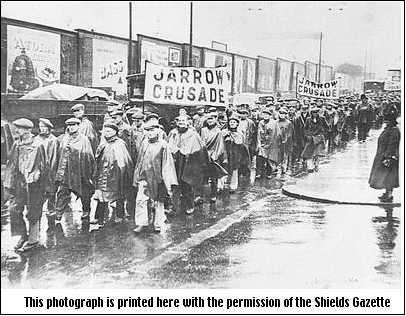 So on the morning of their departure, almost every home in Jarrow was empty, as the townsfolk went to the Town Hall to see the 200 men set off on a 300 mile trek. Leading a prior municipal ceremony was the Mayor, Alderman J W Thompson, and the Town Clerk, Mr C S Perkins, in their robes of office. Also present was the town's MP, Miss Ellen Wilkinson [see the inset above] and Coun. A E Gompertz, secretary of the South Shields Labour Party. Miss Wilkinson had earlier travelled from London, and had previously written a letter to the Times, which included the words: "The town's march - supported by all the political parties on the town council - is to 'present' to Parliament a petition dealing with the permanent causes of Jarrow's plight." ....When she arrived at the first
midday stopping place, Ellen Wilkinson admitted: "I never
expected this Ellen Wilkinson, who led the marchers whenever she could, made an impassioned plea to the Labour Party Conference in Edinburgh, and with tears streaming down her face, said: "Tell the Government, our people shall not starve!" .... There are reports of a mouth-organ band being a great success "keeping the men swinging along all the time" and songs led by leaders including Ellen Wilkinson, who at one time, walked the entire route from Wakefield to Barnsley....... On Saturday, October 31, the marchers finally reached London in heavy rain [see above], headed by Ellen Wilkinson leading the mascot dog, the town's Mayor and 11 councillors. In 1940 Ellen was appointed
Parliamentary Secretary Minister of Pensions, and Joint Parliamentary
Secretary Ministry of Home Security 1940 - 1945. In 1945 she became
Minister of Education and it was in that capacity that on March 1st,
1946, she returned to what was by then Ardwick Central School to
address the whole school in the gymnasium. Ellen charmed the students
with her stories of her escapades at Ardwick including her numerous
visits to the Headmaster's line.
The first floor hall of the Ardwick School had two pillars one on either side of the Headmaster's office. Students who had in some way infringed upon the rules were dispatched to stand boys on one side by the pillar, girls on the other, until the head was ready to deal with them. (This was still the practice in the 1958-65 period when I was at the school.) Ellen, it appears, was a frequent visitor. At that time boys and girls were taught in separate classes, and not infrequently, as a punishment she was sent to join a boys' class. Obviously this was more of a pleasure than a punishment for her. In her book "North Country Bred" Stella Davies shares some of her memories of her friend Ellen Wilkinson. She had this to say about Ellen:
Ellen fought and won the municipal election of 1923 and became a Labour councilor. She was an exceedingly able speaker even in these early days and was particularly good at open-air meetings. Her small figure, generally dressed in green, and her hatless flaming hair made a bright spot of colour in the drab Gorton streets. She was well to the left of the official Labour policy and this, while winning much support from the rank and file of the Gorton electorate, did her no good with the executive body. She had the quality of arousing personal affection and devotion as a public figure. To thousands of men and women in the Labour Party she was known as "Our Ellen" and remained so until the end of her life. The "Top Brass", if such an expression may be used of the Labour Party Officials, only accepted her with reluctance and she won her way into their counsels by sheer weight of personality, hard work, and ability. (225) 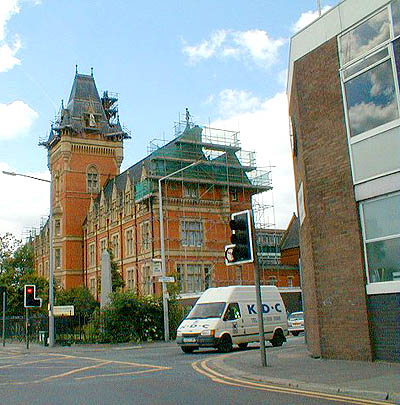 At the end of the 1960s three
schools located at the junction of Hyde Road and Devondhire Street in
Ardwick amalgamated to create what was known as the Nicholl's Ardwick
School. One of the schools involved was the Ardwick Technical
High School which in an earlier form had been Ellen's High
School. It was fitting therefore that the Nicholl's Ardwick
School was later renamed the Ellen Wilkinson High School.
Eventually two of the school buildings were domilished and the former
Nicholl's Secondary School for Boys became the single site for the
Ellen Wilkinson High School.
 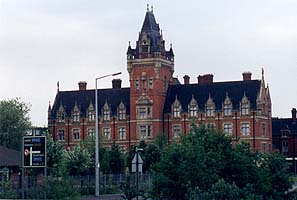 |
